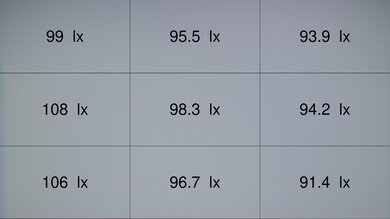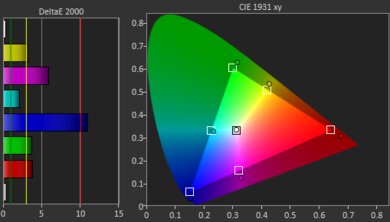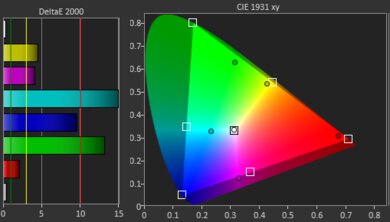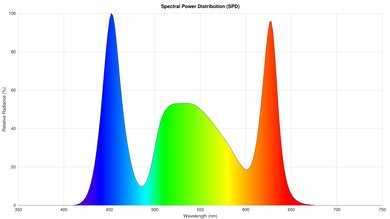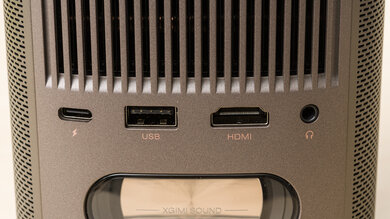The XGIMI MoGo 2 Pro is a lightweight 1080p HDR10 projector. It's small and light, making it easy to carry around, and it's easy to install and use with full vertical and horizontal auto keystone correction, intelligent obstacle avoidance and screen alignment, and autofocus. It uses XGIMI's Intelligent Screen Adaption (ISA) 2.0 technology, which lets it automatically adjust the image more quickly than with ISA 1.0 and without the invasive checkerboard adjustment prompt common on other projectors. The projector uses an LED bulb as its light source with a rated lifespan of 25,000 hours. It can project an image between 40" and 200", although XGIMI recommends that users stick to 60-120 inches for optimal image quality. It has many smart features with the Android TV 11.0 smart interface, Chromecast, Wi-Fi 5, and Bluetooth 5.0. Finally, it has two built-in 8W speakers and can passthrough Dolby Audio, Dolby Digital, and Dolby Digital Plus through ARC.
Our Verdict
The XGIMI MoGo 2 Pro is inadequate for watching movies. It's not bright enough for even moderately lit rooms, so you must turn off the lights. It has a wide color gamut in SDR but isn't bright enough to make colors pop. It has HDR10 support, but it doesn't mean much on a projector this dim. Its contrast is mediocre, so it looks fine, even if rather unimpressive, in dark rooms. The projector has poor pre-calibration image accuracy, but you can significantly improve its accuracy with its basic calibration options, which we highly recommend if you care about accurate colors.
- Full suite of smart features with Wi-Fi 5 and Bluetooth 5.0 support.
- Small and light, and has a slew of image correction features for a quick install.
- Poor brightness levels results in very dim images.
- Poor pre-calibration accuracy, so you really need to calibrate it to get accurate colors.
No Dolby Vision support.
The XGIMI MoGo 2 Pro is a poor choice for gaming. It's a dim projector, so you'll want a dark room to see the image clearly. Plus, its native contrast is only mediocre, so it looks washed out in darker rooms; ultimately, this isn't the best choice if image quality is important to you. It accepts 4k signals but tops out at 60Hz, and the input lag feels sluggish at any resolution.
- Small and light, and has a slew of image correction features for a quick install.
- Poor brightness levels results in very dim images.
- Poor pre-calibration accuracy, so you really need to calibrate it to get accurate colors.
High input lag leads to sluggish gameplay.
Limited resolution support.
No Dolby Vision support.
Changelog
-
Updated Oct 03, 2025:
We made some minor adjustments before our official TBU 0.10 launch.
-
Updated Oct 03, 2025:
We've added text to the Imaging, Optics, Noise, Supported Resolutions, HDR Format Support, 3D, Input Lag, and Audio Passthrough boxes as a result of our latest test bench. We've also added Gaming and Game Mode Responsiveness usages in the Verdict section.
- Updated Oct 03, 2025: We've converted the review to Test Bench 0.10, which updates our Design tests, and adds a whole new suite of Inputs tests. We also added new gaming-oriented usage scores in Our Verdict. See the 0.10 changelog.
-
Updated Aug 15, 2025:
We mentioned the newly reviewed XGIMI MoGo 3 Pro and added a mention of it in the Differences Between Sizes and Variants section.
Check Price
Differences Between Sizes And Variants
Differences between variants
XGIMI sells four closely related MoGo variants: the XGIMI MoGo 2, the XGIMI MoGo 2 Pro, the XGIMI MoGo 3 Pro, and the XGIMI MoGo 4. They share a portable LED design, a fixed 1.2:1 throw, and a 25,000-hour light source, but differ in resolution, image-automation features, smart OS, and hardware extras. The MoGo 2 Pro is the 1080p step-up from the MoGo 2 with more capable auto-setup; the MoGo 3 Pro updates the platform to Google TV and tweaks brightness and speakers; and the MoGo 4 focuses on portability with a built-in battery and a full-size HDMI port. Here's how they stack up:
| Model | Resolution / Engine | Brightness (ISO) | HDR & Notes | OS / Casting | Speakers | Ports (HDMI / USB-C) | Wireless / Storage / Battery |
|---|---|---|---|---|---|---|---|
| MoGo 2 | 720p DLP / LED | 400 ISO lm | HDR10 | Android TV 11; Chromecast built-in | 2 × 8 W | Full-size HDMI 2.0; USB-C power | Wi-Fi 5; BT 5.0; 16 GB; No battery |
| MoGo 2 Pro | 1080p DLP / LED | 400 ISO lm | HDR10 | Android TV 11; Chromecast built-in | 2 × 8 W | Full-size HDMI 2.0; USB-C power | Wi-Fi 5; BT 5.0; 16 GB; No battery |
| MoGo 3 Pro | 1080p DLP / LED | 450 ISO lm | HDR10† | Google TV; Google Cast | 2 × 5 W Harman/Kardon | Micro-HDMI (ARC; HDMI 1.4)‡; USB-C power | Wi-Fi 5; BT 5.1; 16 GB; No battery |
| MoGo 4 | 1080p DLP / LED | 450 ISO lm | HDR10† | Google TV; Google Cast | 2 × 6 W Harman/Kardon | Full-size HDMI (ARC; EDID 1.4/2.0 selectable); USB-C power | Wi-Fi 5; BT 5.1; 32 GB; Built-in 71.28 Wh battery |
† On the MoGo 3 Pro and MoGo 4, HDR10 isn't supported when an HDMI source is connected; HDR works via internal apps/casting.
‡ The MoGo 3 Pro's Micro-HDMI supports HDMI 1.4 only.
Our unit was manufactured in 2023.
Popular Projector Comparisons
The XGIMI MoGo 2 Pro is a small and lightweight projector. It's a disappointing projector overall, and there are better options. The basic XGIMI MoGo 2 is a bit better than the MoGo 2 Pro for a much lower price, so it's the way to go unless you absolutely want to project a 1080p image. If you can stretch your budget a little, the XGIMI Elfin and XGIMI Halo+ are better products as they are brighter and more accurate (more so for the Elfin) than the MoGo 2 Pro. If you don't need a small and light projector, go for the much better and similarly priced Epson Home Cinema 1080 instead, as the Epson is significantly brighter and more accurate than the XGIMI.
Check out our recommendations for the best portable projectors and the best outdoor projectors. If you'd prefer to shop for another product in the same price range, look up the best projectors under $500 instead.
The XGIMI MoGo 2 Pro is a bit better than its successor. While the MoGo 3 Pro is a bit more accurate out of the box, the MoGo 2 Pro is a bit brighter, has better contrast, and has a wider color gamut. It also accepts HDR10 signals through its HDMI port, while the MoGo 3 Pro doesn't; it only plays HDR10 content through its internal apps or through casting. Still, the MoGo 3 Pro is more versatile due to its fully swiveling stand.
The XGIMI MoGo 2 Pro projects a slightly more vibrant image than the Anker Nebula Capsule 3 Laser due to its slightly better peak brightness, but the Anker is much more accurate out-of-the-box and has slightly better contrast. The Anker is also even more portable than the XGIMI as it is lighter and smaller and has an integrated battery, which the manufacturer advertises to last up to 2.5 hours.
The XGIMI MoGo 2 is better than the XGIMI MoGo 2 Pro. The base MoGo 2 gets a bit brighter and has slightly better contrast than the more expensive Pro. While they're both inaccurate, the Pro is even more so out-of-the-box than the MoGo 2. Ultimately, the only advantage of the Pro is that it projects a sharper 1080p image versus 720p for the MoGo 2.
The XGIMI Elfin is better than the XGIMI MoGo 2 Pro. The Elfin is a bit brighter and is the much more accurate of the two projectors. The Elfin can also passthrough advanced audio formats through its eARC port, while the MoGo 2 Pro is limited to ARC.

We've independently bought and tested over 60 projectors, and we've published all the detailed results for each so you can decide which one to buy. These have all been tested under the same standardized methodology, allowing you to compare them side by side. We still have all these projects in our lab so we can continually go back and compare them to ensure our reviews are still accurate. All our test methodology is also public on our website, so you can validate the results yourself.
Throw Calculator
Global Controls
Test Results

The XGIMI MoGo 2 Pro is a dim projector, so you must turn off the lights for a pleasant viewing experience. It does have stellar brightness uniformity, so there's little variation in brightness between the sides and the center.
The XGIMI MoGo 2 Pro's contrast is mediocre, as its blacks are just not that dark when contrasted with its very dim whites. Overall, it will look fine but unimpressive in a dark room.
The XGIMI MoGo 2 Pro projector has poor color accuracy out-of-the-box. Its white balance and colors are quite inaccurate, with reds and blues being overrepresented in all shades of white except near blacks. All colors are somewhat inaccurate, with blues, cyans, and whites being the worst. Thankfully, the projector's color temperature is excellent, even if it's slightly on the cold side.
The XGIMI MoGo 2 Pro only has one-point white balance calibration, but it's enough to improve the projector's image accuracy significantly. The unit's white balance is now excellent, with only near blacks still showing some errors. After calibration, colors are passable, although purples, blues, and reds still show obvious deviations from what they should be. The color temperature is now fantastic, albeit slightly on the warm side.
The projector has a wide color gamut. It covers nearly all of the Rec. 709 color space used with SDR content, although its blues are noticeably inaccurate. It does an adequate job with the wider Rec. 2020 color space used with HDR content.
The XGIMI MoGo 2 Pro uses a single-chip DLP engine and an LED light source rated for a long lifespan, so there's no lamp to replace. It's a 1080p projector; it can accept 4k inputs and downscale them, but it isn't a native or pixel-shift 4k unit. The LED's spectral power distribution shows narrow peaks around the primaries rather than the broad curve you see with lamps. That helps it give SDR colors a clean look, though peak saturation and overall luminance aren't in the same league as larger, brighter laser models.
This is a fixed-lens design (1.2:1) with motorized focus and XGIMI's ISA 2.0 doing most of the heavy lifting. ISA 2.0 also includes Intelligent Screen Alignment and Obstacle Avoidance. Horizontal and vertical auto-keystone are handy in a pinch, but like all digital warping, they add a touch of processing and soften edges a bit, so use physical placement first, then let ISA clean up the last few percent if you need to. You can still fine-tune focus manually if needed.
Here are some practical 16:9 throw distances you can use when placing it:
- 40″ → ~3.5 ft
- 60″ → ~5.2 ft
- 80″ → ~7.0 ft
- 100″ → ~8.7 ft
- 120″ → ~10.5 ft
XGIMI recommends staying in the 60–120″ range for best results. You'll get the sharpest image by centering the lens on the screen and avoiding keystone when you can.
The XGIMI MoGo 2 Pro has a compact design and weighs only 2.4 pounds, but it doesn't have an integrated battery, so you still need to plug it into an outlet. It can be charged through its USB-C port with an external power bank (not included with the unit) as long as it has a power output of 65W and above. It has full auto keystone correction, autofocus, intelligent screen alignment, and obstacle avoidance, so it's very easy to set up.
The projector has two integrated 8W speakers, so you won't need to worry about connecting it to a soundbar or audio system when bringing it with you. It doesn't have an adjustable stand in the box, but XGIMI sells a multi-angle stand for the MoGo and Halo series separately.
Fan noise is low for a portable projector. Still, it's louder if you run it in its Performance Mode. That mode turns the image very green, however, so we don't expect many to use it. Outside of that mode, the unit is pretty quiet and will be drowned out by the content or by ambient noise.
The device has Wi-Fi 5 and Bluetooth 5.0 and can passthrough Dolby Audio, Dolby Digital, and Dolby Digital Plus through ARC. Its USB-C port is for power delivery only, and you can charge the unit with its included power supply or with an external power bank (not included) with a power output of at least 65W.
The XGIMI MoGo 2 Pro 1080p portable projector accepts up to 4k @ 60Hz and downscales it to its native 1080p resolution. Unfortunately, even though the EDID shows that the projector is capable of full chroma 4:4:4 at 1080p, in practice, the text is very fuzzy.
Latency is on the high side and feels best in Game Mode, but even there, it's too slow even for slower story-driven titles, except perhaps turn-based games. There's no 120Hz support here to cut lag further.
The XGIMI MoGo 2 Pro has a single HDMI port that also serves as ARC (not eARC), and there are no dedicated audio-passthrough controls in the UI. We verified that ARC works for audio from the projector's internal Android TV apps to an AVR/soundbar, but because there's only one HDMI, the projector can't take an external HDMI source and pass that audio out at the same time.
From the EDID handshake (Murideo readout), ARC advertises:
- LPCM 2.0 at 16/24-bit, 32–192kHz
- Dolby Digital (AC-3) 5.1 at 32/44.1/48kHz
- Dolby Digital Plus up to 7.1 at 32/44.1/48kHz (Atmos via DD+ works where available)
DTS formats aren't advertised, and there's no eARC, so lossless codecs like Dolby TrueHD/Atmos via TrueHD or DTS-HD/DTS:X won't bitstream. If you need full surround from external players, route sources through your AVR first (HDMI out to the projector) or use an HDMI audio extractor; ARC from the projector is best treated as an "apps to soundbar/AVR" path only.

